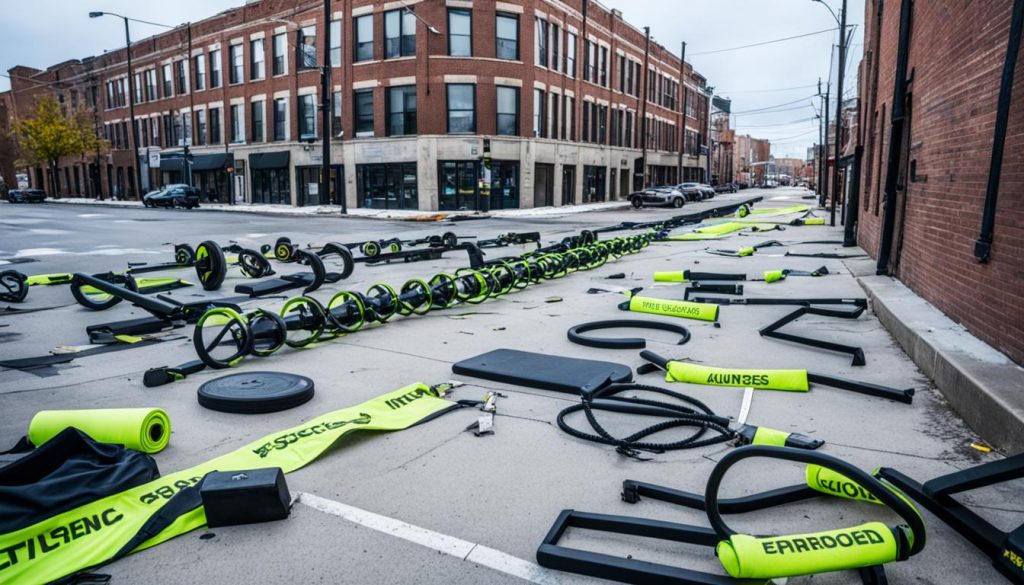Did you know that urban environments are more prone to emergencies such as natural disasters, terrorist attacks, and mass shootings?
In today’s fast-paced world, being prepared for unexpected challenges is more important than ever. That’s where urban survival fitness comes in. It’s not just about physical strength and endurance; it’s about equipping yourself with the skills and mindset to thrive in urban environments, no matter the circumstances.
Urban survival fitness combines physical training, mental resilience, and practical skills to help you navigate through the concrete jungle with confidence and adaptability. Whether it’s self-defense techniques, metropolitan survival exercises, or urban physical conditioning, every aspect is designed to prepare you for the unique challenges that urban living presents.
In this article, we will explore the importance of resilience in urban survival, strategies for building resilience in urban environments, mental resilience techniques for urban survival, the role of community in urban resilience, and more. Let’s dive in to discover how urban survival fitness can empower you to overcome any urban emergency.
Key Takeaways:
- Urban survival fitness prepares individuals to thrive in urban environments during emergencies.
- Resilience is crucial in urban survival, enabling individuals to remain calm and make effective decisions under high-stress situations.
- Strategies like urban self-defense training, metropolitan survival exercises, and urban physical conditioning help build resilience in urban settings.
- Mental resilience techniques, including stress management and problem-solving skills, are essential for overcoming adversity in urban environments.
- Community resilience and urban preparedness networks play a significant role in urban survival by fostering support and collective action during emergencies.
The Importance of Resilience in Urban Survival
Resilience plays a critical role in urban survival situations. In bustling cities, individuals face the constant risk of emergencies such as natural disasters, terrorist attacks, and mass shootings. To navigate these high-stress situations effectively, it is essential to possess resilience.
Resilience empowers individuals to maintain a calm demeanor, make rational decisions, and take appropriate actions during emergencies. It allows them to adapt quickly to changing circumstances and overcome challenges while preserving their physical and mental well-being.
To enhance urban emergency preparedness, individuals need to acquire the necessary knowledge and skills to respond to a wide range of potential threats. This includes understanding evacuation procedures, first aid techniques, and self-defense strategies that are specific to urban environments.
One effective approach to building resilience in urban environments is through urban fitness classes. These classes provide practical training and exercises that simulate the challenges individuals may face during urban survival scenarios.
Urban fitness classes offer a holistic approach to physical and mental conditioning, focusing on increasing strength, endurance, flexibility, and mental agility. Participants learn practical self-defense techniques, develop their situational awareness, and cultivate the resilience needed to stay calm and composed in high-pressure situations.
“Urban fitness classes provide a vital platform for individuals to develop the physical and mental resilience required in urban survival scenarios.” – James Anderson, Certified Fitness Instructor
By participating in urban fitness classes, individuals not only improve their physical fitness and self-defense capabilities but also develop the mental fortitude necessary to thrive in urban environments. The training exercises simulate real-life challenges, helping individuals build confidence in their abilities and stay calm amidst chaos.
Benefits of Urban Fitness Classes for Resilience in Urban Survival
- Enhanced physical fitness and self-defense skills
- Improved mental agility and focus
- Increased situational awareness and adaptability
- Heightened confidence and self-belief
- Better stress management and emotional regulation
Urban fitness classes provide a supportive and encouraging environment where individuals can challenge themselves, overcome obstacles, and work towards achieving optimal physical and mental resilience. In addition to the physical benefits, these classes foster a sense of community and camaraderie among participants, further enhancing their ability to thrive in urban survival scenarios.
Strategies for Building Resilience in Urban Environments
When it comes to urban survival, building resilience is essential. In order to thrive in challenging and high-stress situations, individuals need specific strategies and training tailored to urban environments. By equipping themselves with the right skills and techniques, they can confidently navigate potentially dangerous situations and effectively respond to emergencies.
One crucial aspect of building resilience in urban environments is urban self-defense training. This training focuses on equipping individuals with the necessary skills to protect themselves and stay safe in cities. From learning effective self-defense moves to understanding situational awareness, urban self-defense training provides practical knowledge that can make a significant difference in urban survival scenarios.
Metropolitan survival exercises are another valuable strategy for building resilience in urban environments. These exercises simulate real-life scenarios, allowing individuals to practice their response skills and decision-making abilities in a controlled environment. By experiencing and learning from these simulated emergencies, individuals can develop the confidence and competence needed to handle stressful situations with resilience.
Urban physical conditioning is also a key component in building resilience. Enhancing physical fitness through targeted exercises improves strength, endurance, and mobility, enabling individuals to better withstand the physical demands of urban survival. It not only strengthens the body but also boosts mental resilience, as physical fitness promotes overall well-being and reduces stress.
By combining urban self-defense training, metropolitan survival exercises, and urban physical conditioning, individuals can develop a comprehensive set of skills and strategies to build resilience in urban environments. Let’s take a closer look at the benefits of each:
| Strategies | Benefits |
|---|---|
| Urban Self-Defense Training | – Empowers individuals to protect themselves – Enhances situational awareness – Builds confidence and self-esteem |
| Metropolitan Survival Exercises | – Prepares individuals for real-life emergencies – Develops decision-making skills – Builds resilience under pressure |
| Urban Physical Conditioning | – Improves strength, endurance, and mobility – Enhances overall physical and mental resilience – Reduces the risk of injuries |
Building resilience in urban environments is crucial for urban survival. By investing time and effort into these strategies, individuals can strengthen their ability to adapt and overcome the challenges they may face. Whether it’s a natural disaster, a personal safety threat, or any other urban emergency, being resilient can make all the difference.
Mental Resilience Techniques for Urban Survival
Mental resilience plays a crucial role in urban survival. In the face of adversity, developing the psychological resilience necessary to navigate and overcome challenges is essential. Urban survival skills training focuses on equipping individuals with the tools and techniques to cultivate this resilience in urban environments.
Stress Management
One of the key aspects of urban survival skills training is stress management. In high-pressure situations, staying calm and composed is vital for making rational decisions. Techniques such as deep breathing, meditation, and mindfulness can help individuals to regulate their stress response and maintain a clear mindset even in stressful urban environments.
Problem-Solving Skills
Urban survival often requires quick thinking and problem-solving. Training individuals in effective problem-solving skills equips them to identify and assess potential risks, evaluate available resources, and develop strategic plans to address emergencies. By honing these skills, individuals can navigate complex urban environments with confidence and efficiency.
Realistic Planning
Realistic planning is a crucial aspect of urban survival skills training. It involves developing the ability to anticipate potential dangers and devise practical strategies to mitigate them. Through scenario-based exercises and simulations, individuals learn to assess their surroundings, identify safe routes, and prepare for potential threats, ensuring they are better equipped to handle unforeseen circumstances in urban settings.
Emotional Regulation
Emotional regulation is vital for maintaining mental resilience in urban survival situations. It involves recognizing and managing one’s own emotions, as well as responding effectively to the emotions of others. By learning techniques such as emotional awareness, self-control, and empathy, individuals can navigate challenging social dynamics and maintain a level-headed approach, fostering greater resilience in urban environments.
By incorporating these mental resilience techniques into urban survival skills training, individuals can develop the psychological tools necessary to overcome the unique challenges of urban environments. Whether it’s staying calm in high-pressure situations, solving problems effectively, planning realistically, or regulating emotions, these skills are essential for urban survival.
The Role of Community in Urban Resilience
Community resilience is a fundamental aspect of urban survival. By building strong connections and support systems within the community, individuals can enhance their ability to withstand and recover from emergencies. In times of crisis or disaster, communities have a unique power to come together, providing vital assistance and resources that foster resilience in individuals.
One key component of community resilience is the establishment of urban preparedness networks. These networks consist of individuals, organizations, and local authorities that collaborate to promote effective communication, coordination, and collective action during emergencies. By working together, these networks can leverage the diverse skills and resources within the community to enhance overall resilience.
Through collaboration and cooperation, urban preparedness networks strengthen response capabilities and facilitate efficient recovery in the aftermath of urban emergencies. By pooling their knowledge, skills, and resources, these networks can promote community resilience on a broader scale.
The Benefits of Community Resilience:
- Increased access to information and resources during emergencies
- Supportive social networks that provide emotional and practical assistance
- Collective problem-solving and decision-making
- Enhanced communication and coordination among community members
- Promotion of mutual assistance and solidarity
By fostering community resilience, individuals can rely on the strength and support of their neighbors and local organizations in times of crisis. This collaborative approach to urban survival enhances the overall preparedness and resilience of the entire community.
Conclusion
Urban survival fitness is a comprehensive approach that prepares individuals to thrive in challenging and high-stress urban environments. By engaging in physical and mental preparation, developing specific skills, and implementing effective strategies, individuals can build resilience and navigate through the concrete jungle with confidence.
Building resilience is an ongoing process that requires cultivating a growth mindset and developing coping skills. This includes practicing gratitude, compassion, acceptance, and forgiveness, as well as finding meaning in difficult situations. It is also crucial to foster supportive social networks that can provide the necessary emotional and practical support during times of adversity.
By embracing urban survival fitness, individuals can equip themselves with the tools needed to adapt to the unique challenges and emergencies that may arise in urban settings. Whether it’s urban self-defense training, participating in metropolitan survival exercises, or focusing on urban physical conditioning, the goal is to enhance physical and mental capabilities. With resilience, individuals can confidently face any urban survival situation that comes their way.



